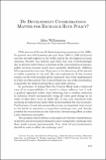Mostrar el registro sencillo del ítem
Do development considerations matter for exchange rate policy?
| dc.contributor.author | Williamson, John | |
| dc.coverage.spatial | CHILE | es_ES |
| dc.date.accessioned | 2019-11-01T00:04:06Z | |
| dc.date.available | 2019-11-01T00:04:06Z | |
| dc.date.issued | 2008 | |
| dc.identifier.isbn | 978-956-7421-30-5 | |
| dc.identifier.uri | https://hdl.handle.net/20.500.12580/3742 | |
| dc.description | Chile was one of the world’s fastest-growing economies in the 1990s. Its growth rate of 6.8 percent per year from 1990 to 2000 (inclusive) was the seventh highest in the world, and by far the highest in Latin America. Poverty was halved, and while this was overwhelmingly due to growth rather than a reduction in the concentration of income, public services became much more equitably distributed. Inflation fell progressively from over 20 percent at the beginning of the decade to under 4 percent at the end. My own explanation of this success centers on the well-rounded policy measures that were implemented in Chile over the period. The Central Bank was one of the institutions responsible for implementing these successful policies. | |
| dc.format | ||
| dc.format.extent | Sección o Parte de un Documento | |
| dc.format.medium | p. 475-489 | |
| dc.language.iso | eng | |
| dc.publisher | Banco Central de Chile | |
| dc.relation.ispartof | Series on Central Banking, Analysis, and Economic Policies, no. 12 | |
| dc.rights | Attribution-NonCommercial-NoDerivs 3.0 Chile | * |
| dc.rights.uri | http://creativecommons.org/licenses/by-nc-nd/3.0/cl/ | * |
| dc.subject | TIPO DE CAMBIO | es_ES |
| dc.subject | POLÍTICA MONETARIA | es_ES |
| dc.subject | DESARROLLO ECONÓMICO | es_ES |
| dc.subject | BANCO CENTRAL DE CHILE | es_ES |
| dc.title | Do development considerations matter for exchange rate policy? | |
| dc.type.doc | Artículo | |
| dc.file.name | BCCh-sbc-v12-p475_489 |


